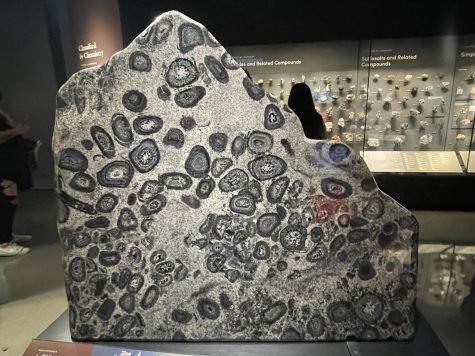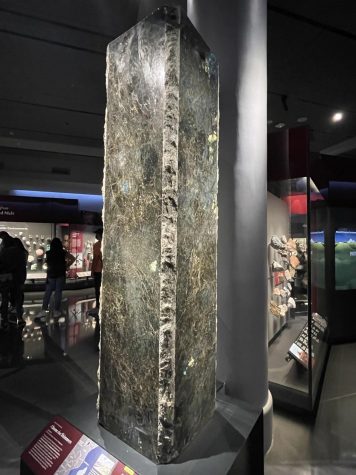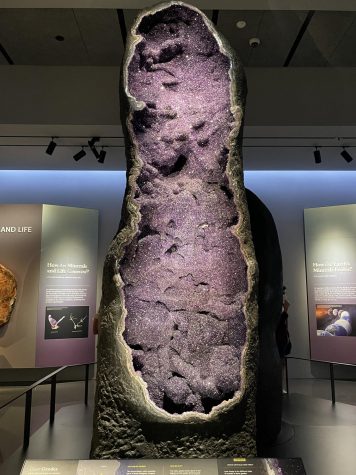Extraordinary Minerals of the American Museum of Natural History
December 16, 2021
Recently I had the opportunity to visit a place full of rich history and many great wonders, in which it was the filming location/setting of the “Night at the Museum” movies; I saw, and explored, the “American Museum of Natural History”.
Within its vast walls held so many exhibits that I could seldom find my way without a map.
Of the many attractions, one that enraptured a lot of visitors, the entrance to the room itself, being extremely narrow, that a few guards stood upfront to help direct the flow of traffic; why it was none other than the “Allison and Roberto Mignone Hall of Gems and Minerals”.
In the magnificent “Hall of Gems” over 2,000 specimens reside in original, carved, or jewelry form; sometimes it’s all three. There are rows upon rows of minerals behind glass, labeled in great detail, the description even says the location of where the gem had been found; often next to these smaller display cases, larger versions can be found.
Off to the side of the main halls is a small trove of jewelry, inside you can learn the process of how precious stones become incorporated into jewelry; seeing the finished product compared to the original piece, you might consider it a bit of a downgrade. Other than that ancient vases and artifacts, from every region, and of great popularity reside; such as the “Tiffany Diamond”, famously worn in the movie “Breakfast at Tiffanys”, and the Opal Pendant, created by Louis Comfort Tiffany and inspired by Claude Monet’s painting “The Water-Lily Pond”.
While I could easily write an entire book series on the majesty of the museum’s geology department, I’m only going to pick one subject to elaborate on; and that will be the “Signature Mineral Specimens”.

The “Gargantuan Garnet”, weighing 14,500 pounds, or 6,577 kilograms, truly is a brilliant example of natural engineering.
The base rock, formed over 1-billion years ago, and discovered, 16 miles underground New York’s Gore Mountain, located in the Adirondack Mountains; is an ordinary sediment but the garnets splattered across its surface, each measuring up to 1 foot in length, is truly an unusual sight.
Not only are they an unusual addition, they’re the result of an atmospheric pressure of 8,000 pounds, 544.2 times greater than the usual average of 14.7 pounds; the temperature during this was 1500 degrees Fahrenheit or 815 degrees Celsius, about 25.4, degrees Fahrenheit, or 54.3, degrees Celsius, times greater than the global temperature average.
The texture of the rock itself can raise some questions, due to many of the garnets being cracked along the parallel planes, it’s been described as feeling abrasive, similar to sandpaper; I was allowed to touch the exhibit and yes, it felt exactly as described.

The “Spectacular Stibnite”, smaller than the “Gargantuan Garnet” at a weight of only 838 pounds, or 380 kilograms, looks to be a statuette belonging to an ancient gothic architecture.
Stibnite, also known for its scientific name of Sb2S3, is made from a combination of the 2 elements, antimony and sulfur; and while this occurrence usually results in a swarm of grand crystalline structures, the extent of the “Spectacular Stibnite’s” scale and intricacy is the first of it’s kind to ever be recorded.
Approximately 130 million years old, and making its home within the circumference of a highly active volcanic site, while it’s said to have lived around the site, in the Southeastern region of China; while it’s said to have lived around the corner of the natural disaster, rumor has it the gem could’ve possibly formed inside the catalyst.
Through the hydrothermal process, the technique of crystallizing substances by various solutions, the mineral was synthesized using boiling hot water, explaining the whispers of a magma origin; strong enough to dissolve natural components, while being transported throughout various fractures and porous rocks.

The “Luminous Labradorite” weighs 3,000 pounds, or 1,400 kilograms; its beauty can rival the brilliance of an active lighthouse on an exceptionally dark and foggy night.
In-between the collision of tectonic plates, the aforementioned specimen is the unusual byproduct of an igneous growth, known as an intrusion; its estimated age is roughly over 550 – 630 million years old.
Even though it’s discovery was in Madagascar, one could argue the gem had two separate creations; the second being the formation of layers upon layers of individual crystals within the structure, a few measuring up to 1 yard or 1 meter in length, 3 feet or 36 inches.
I may have compared this specimen to an average lighthouse, and surprisingly I wasn’t too far from the truth; at first glance the surface appears to be a simple and average grey, but rotating yourself to a different angle will reveal an archaic arrangement of colors with the tower.

The “Amethyst Geode”, one of two specimens, the latter of which I’ll be focusing on, was so massive in size; that not only did it very nearly reach the floor’s ceiling, but I had to take its picture at the highest zoom-out setting I had, while still needing to back up if I wanted to capture its entire majesty.
Despite its incredible height there isn’t much to show for in weight, coming in at 9,040 pounds, or 4,100.
Similarly the hydrothermal process, by excessively hot water, was also used here; to transport dissolved minerals, which took part in the creation of the white inner-shell and the grey outer-shell, an amalgamation of brown chalcedony and a variety of smaller quartz crystals.
The color didn’t actually start off as a brilliant purple but with an average smoky appearance; it later turned, due to radiation from the host rocks it lived in, getting more vibrant from exposure and the bygone time.
Taking nearly 135 million years to form, it’s incredible that this is the result of a very minimal formation cycle; although nothing in comparison to the “Gargantuan Garnet, but still similar to the “Spectacular Stibnite”.
I’ve gotten quite lucky recently, in being able to visit this gorgeous museum and one day, hopefully, I’d love to be able to go again. Besides the “Mignone Hall of Gems and Minerals” there are a great many things to be seen; even though permanent exhibitions are a favored classic of mine, it’s exciting to see the short-term ones which are only on display for a limited time.
Interested in all things living, try the “Hall of Biodiversity”; its’ masterpiece, in my opinion, is “The Spectrum of Life”, a diorama containing preserved specimens of over 1,500 different species. Or perhaps you’d like to stick with something more in-tune with minerals, why not take a look at the “Arthur Ross Hall of Meteorites”; even though it’s separate from the planetarium, a section of the museum designated to all things space with a variety of exhibition topics and focuses, it hosts just as much information of the world beyond our stars.
So please, if you haven’t had the chance to yet, find a way to the “American Museum of Natural History” as soon as possible.

